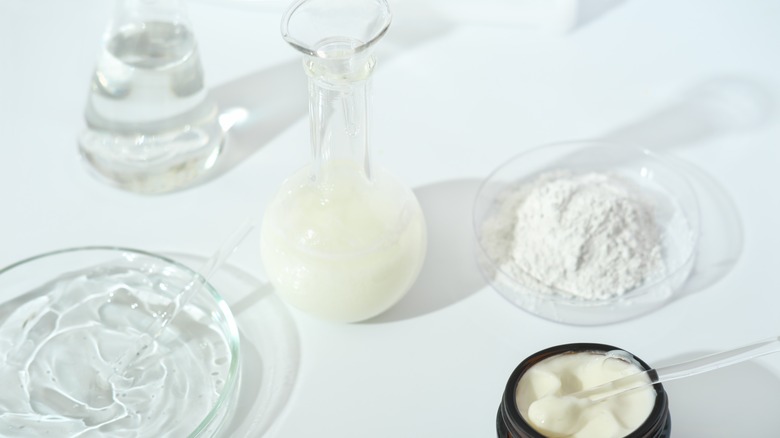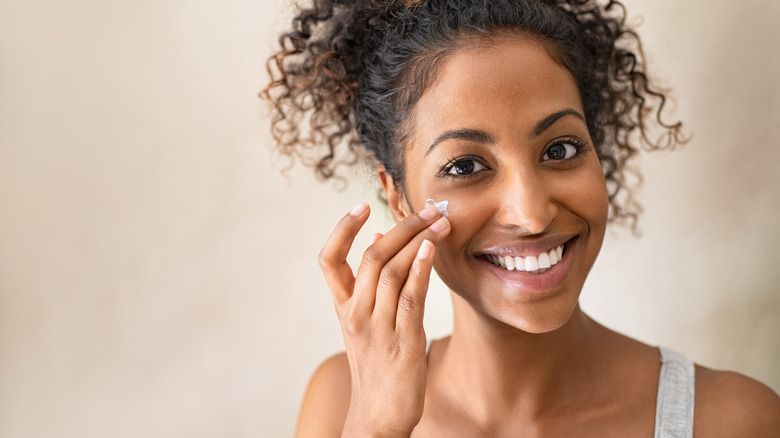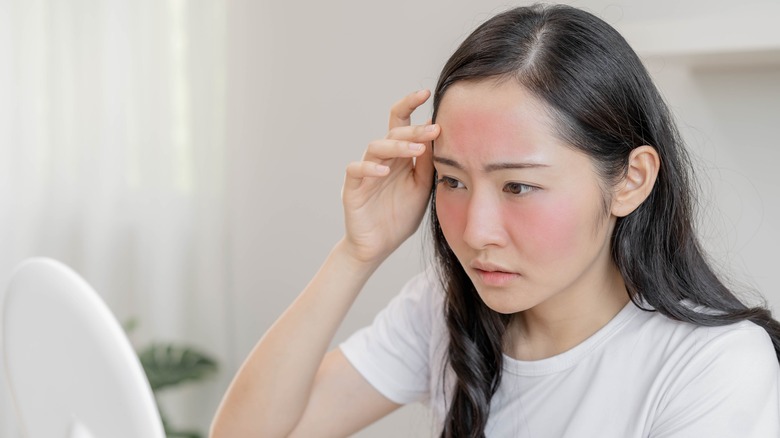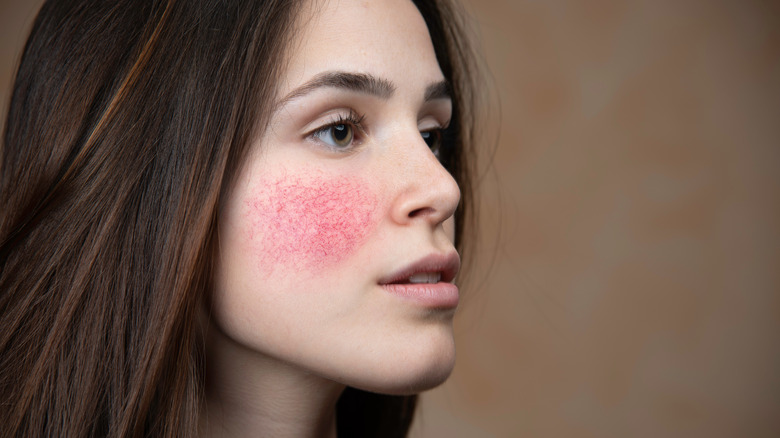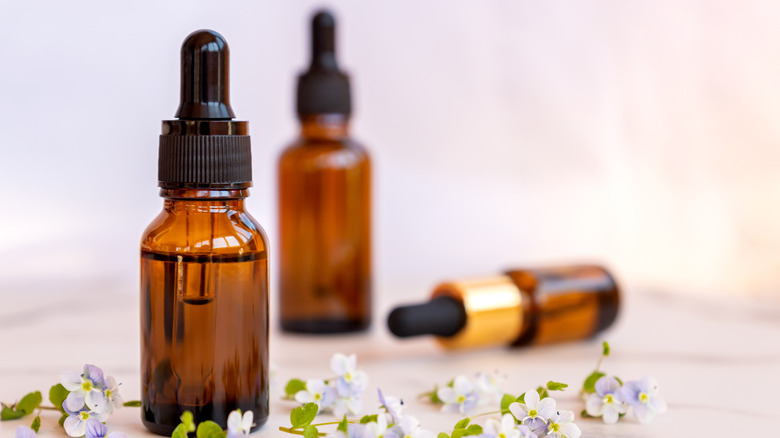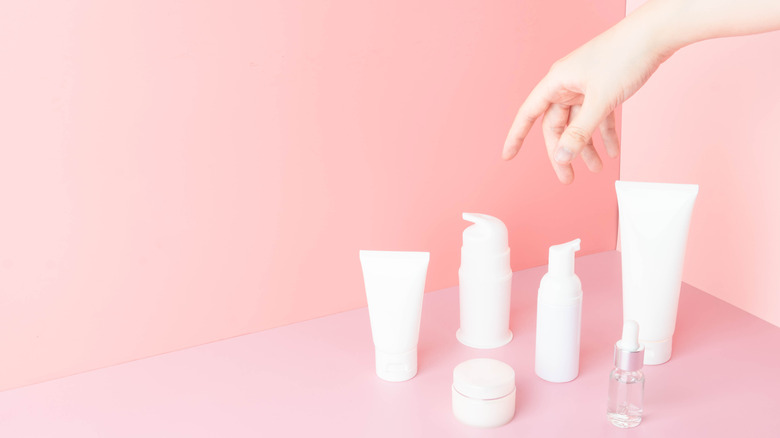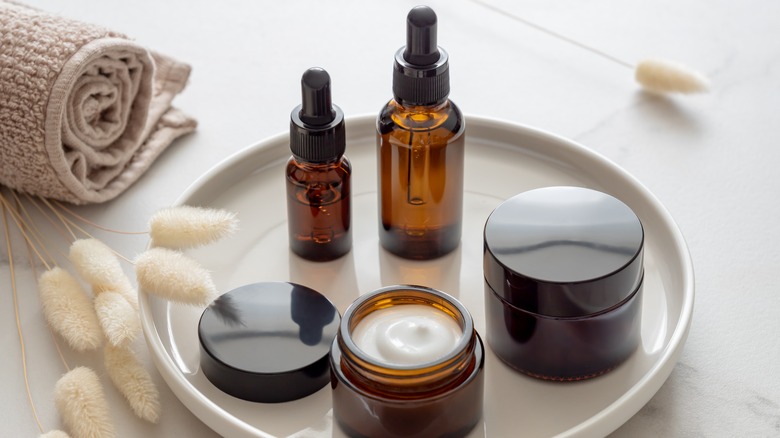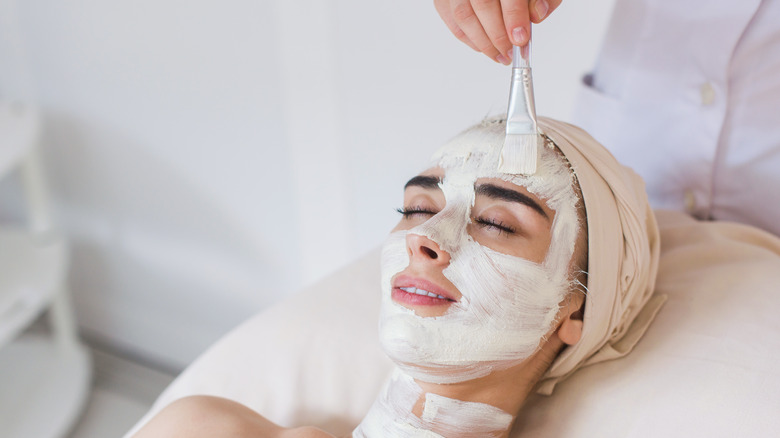Everything You Need To Know About Adding Lactic Acid Into Your Skincare Routine
We may receive a commission on purchases made from links.
It's no secret that all-natural products can work wonders for our skin. Mother Nature has a way of taking care of some of our most common skin concerns, and lactic acid is definitely one of her gifts to humankind. Yes, we're indeed referring to the compound you find in sour milk, and while you're free to wash your face with the expired milk in your fridge, you could rather opt for the wide range of skincare products that contain this near-magical compound.
Acids have been part of skincare regimes for hundreds of years — even Cleopatra used lactic acid for its exfoliating properties (via JAMA Dermatology), which means it must have some sort of magical effect. At their core, acids work to give you skin that looks and feels healthy while addressing various skin concerns. "Acids are active ingredients that address a number of different skincare concerns depending on the molecular size of the acid and its strength," celebrity skin expert Harshna Bijlani told Vogue.
If the benefits sound amazing but you're terrified of burning your skin to a crisp, fear not. Lactic acid is actually pretty gentle; you just need to find the right product for your skin type. Of course, that's easier said than done, but with a few tips, you can use it with ease.
What is lactic acid?
In short, lactic acid is an all-around multitasker that most skin types will love. It forms part of the AHA (alpha hydroxy acids) family, which means it does a brilliant job in encouraging skin cell turnover, as dermatologist Christina Psomadakis tells Elle. AHAs help get rid of dead skin cells by dissolving the protein bonds that keep them tethered to the skin, leaving you with a healthy glow.
Lactic acid, at its core, is a gentle exfoliator, but depending on the concentration you use, it can also serve as a moisturizer and help protect your skin's gentle barrier. Facialist Kate Somerville says that, while many exfoliators on the market can be quite harsh on the skin, lactic acid is as gentle as they come, thanks to its composition. "Lactic acid possesses larger molecules than glycolic, meaning it won't penetrate the surface of your skin as well, leading to a lighter degree of exfoliation," Somerville explains (via Elle).
The best part is that most lactic acid products are vegan. Yes, lactic acid is primarily produced through the fermentation of dairy products, but for skincare purposes, it's usually created synthetically in labs.
Aside from its potential to be a great moisturizer and gentle exfoliator, lactic acid has other benefits as well. "... Studies have shown that it can increase skin firmness, reduce fine lines and improve skin texture," Psomadakis says. Add to cart — now.
Lactic acid has various skin benefits
If you struggle with pesky breakouts or acne flare-ups, lactic acid is about to become your new bestie, all thanks to its gentle exfoliating abilities.
"Acids can remove several layers of dead skin in just one treatment allowing treatment products and skincare to effectively penetrate the skin," board-certified dermatologist Michele Green told InStyle. So, not only will lactic acid help you to reveal new healthy skin, but it will also help your other skincare products work harder. Sweet.
Cosmetic chemist Michelle Wong points out that lactic acid will give your skin the best of both worlds: It's a humectant (meaning it locks in moisture), while also reducing and preventing clogged pores to prevent acne and breakouts. A 1985 study actually found that lactic acid is a real hero when it comes to killing bacteria on the skin. This study focused solely on lactic acid's effect on infants suffering from skin infections. Its thought that these same antibacterial properties are what help lactic acid fight acne.
Aside from kicking acne's butt, lactic acid can also help you out if you struggle with hyperpigmentation, sun spots, or skin discoloration. As for its anti-aging properties, a 1996 study published in the Journal of the American Academy of Dermatology found that the higher the concentration of lactic acid used on the skin, the more significant its impact on wrinkles. A concentration of 12%, for instance, penetrates both the skin's dermis and epidermis, targeting wrinkles where it matters most and improving the skin's elasticity.
Lactic acid can also cause some side effects
While lactic acid has amazing skin benefits, it doesn't come without some risks, and you might experience some side effects when you use it for the first time.
Even though lactic acid is considered a gentler AHA, you shouldn't underestimate its potency and use too much. According to the U.S. Food and Drug Administration, AHAs can cause some skin irritation. You might experience burning, swelling, itchiness, redness, dryness, and peeling. Usually, it's pretty normal to experience some of these uncomfortable side effects when you apply lactic acid for the very first time. But if you want to cry with pain and the discomfort persists, you should probably steer clear of it. However, if the initial burning and redness are mild and disappear within an hour, you should be good to continue using it. If not, wash off the product, especially if you experience swelling or a rash in addition to general redness and discomfort. If side effects persist, consult with your doctor or dermatologist.
Speaking to Vogue, celebrity skin expert Harshna Bijlani explained that lactic acid can cause your skin to become very sensitive to the sun as well, so always make sure you wear a good sunscreen if you use lactic acid in the a.m. To play it safe, Bijlani suggests you incorporate lactic acid into your evening skincare routine. She also cautions against using a formula that's too strong. "Ideal strength should be lower than 8%," she says.
Which skin types will benefit the most from lactic acid?
Speaking to Ipsy, dermatologist Patricia Wexler, M.D., said that lactic acid is actually one of those rare skincare products that work great for all skin types. Yes, even sensitive skin usually reacts kindly to this acid, thanks to the fact that it's a much gentler exfoliator. Board-certified dermatologist Lian Mack, M.D., adds to Women's Health that even if you've had a bad experience with other acids previously, it's worth giving lactic acid a try. "It's not as irritating as other AHAs and BHAs like glycolic and salicylic acids," he assures.
However, Wexler warns that you should assess your current skincare routine before adding lactic acid to your inventory. If you're already using other AHAs, lactic acid's additional exfoliating properties might be too hard on your skin and cause irritation. Even if lactic acid is the only AHA you use, Wexler says you should be careful not to overdo it. Yes, it's gentler than other acids, but too much of it will leave you with irritated and inflamed skin.
Dermatologist Cristina Psomadakis agrees with Wexler. Speaking to Elle, she warned that you can do a lot of damage if you go overboard. "Overdoing it means compromising the integrity of your skin barrier and can lead to problems like irritation, infection, and the development of product allergies," she says. To keep your skin happy and your skin barrier intact, Wexler recommends using lactic acid alongside other nourishing ingredients, including hyaluronic acid.
Skin types that won't tolerate lactic acid
Even though lactic acid is usually marketed as being suited for all skin types, there are some instances where it's better to steer clear of it.
There's sensitive skin, and then there's extreme can't-put-anything-on-your-face sensitive skin. Dermatologist Cristina Psomadakis told Elle that lactic acid might do more harm than good for people who struggle with certain skin conditions. "Anyone with extremely sensitive skin, particularly those with skin conditions like eczema or rosacea, should be very cautious when using any exfoliating product and may have to avoid them altogether," she warns. Furthermore, Greatist cautions that those who have psoriasis should also be careful when trying lactic acid.
If you have any of these skin conditions and feel like you really need a gentle exfoliator, Psomadakis says it's imperative you do a patch test first before subjecting your whole face to it (via Elle). She added that everyone, regardless of their skin type, should patch test products before using them on their face. She also advises you to start with the weakest concentration available and slowly build it up over time so your skin can get used to it. Less is always more, and the best products take time to work. There's no such thing as an overnight transformation — patience is key.
What makes lactic acid different from other skincare acids?
We'll forgive you if you're still skeptical about lactic acid's ability to treat sensitive skin. If you've been burned before (perhaps literally), it can be hard to trust a chemical exfoliator again. However, lactic acid's chemical makeup ensures that it won't be too hard on skin that's prone to sensitivity. According to MDedge, lactic acid contains larger molecules than other acids. Because of this difference in size, it can't sink into your skin as deeply as its counterparts. This means it primarily treats the surface of your skin without going any deeper than that, and this is why sensitive skin can tolerate it.
According to a 2018 study published in the Journal of Clinical and Aesthetic Dermatology, lactic acid can work just as well as glycolic acid without the added risks and side effects. It has a lower pH and can do just as great a job of exfoliating the skin, even when it's used in lower concentrations. This makes it one of the safest and gentlest acid options out there.
You can also combine lactic acid with other acids in some cases. If you have sensitive skin and struggle with acne, Byrdie recommends you add salicylic acid to your skincare routine alongside lactic acid (just don't apply them on the same day). Since salicylic acid penetrates deeper into the skin, it will do a better job of clearing your pores, while lactic acid will help take care of the dead skin cells on the surface.
Tips for incorporating lactic acid into your skincare routine
Skincare routines can be a bit complicated — we know. When you add a new product to your regimen, it's important to do some research to make sure you know exactly how and when to use it.
It's best to reserve lactic acid for your nighttime routine, board-certified dermatologist Elyse Love, M.D. told Dermstore. This is because lactic acid and sunshine don't go together so well. "As it makes new skin grow, which may not have any pigment in it, it may cause increased susceptibility to sunburn," chief chemist at Colonial Dames Co. Raymond Schep told Byrdie.
Love recommends you use lactic acid a maximum of three times a week and gradually increase the usage so your skin can adjust. As for whether you can use it more frequently, Love says it varies from person to person, explaining, "How often you ultimately use it depends on what your skin needs. That may change by season or even the week."
Celebrity aesthetician Renée Rouleau recommends you follow what she calls the "three-on/three-off schedule" (via Byrdie). This basically means that you'll apply lactic acid continuously for three nights and then follow with a moisturizing regimen for the next three days. Rouleau says this works great because it allows you to effectively uncover new skin cells and then moisturize them properly. Last, but not least, Schep says to remember to wear sunscreen every day. Choose a sunscreen that has an SPF of at least 30 to ensure maximum protection.
Lactic acid isn't safe to use with certain skincare products
If you've ever ended up with irritated skin after incorporating a new product into your skincare routine, it was likely because you combined two products that aren't exactly besties. While this is a common mistake, it's one you should try to avoid.
Speaking to PopSugar, director of cosmetic dermatology at South Shore Medical Center Joyce Imahiyerobo-Ip, M.D., said that those with sensitive skin should be extra careful when they start combining active skincare products, and this includes lactic acid. "Some active ingredients used in skin-care products can act as irritants when mixed with others," she explained. Stinging, redness, and flakiness are some of the telltale signs that you've applied the wrong combination of active ingredients. In other cases, combining certain compounds won't necessarily cause your skin to freak out, but it can lead to the products canceling each other out, which means you won't reap any of the benefits.
Speaking to Dermstore, board-certified dermatologist Elyse Love, M.D., warned that you shouldn't combine lactic acid with any other exfoliants, and if you use retinol, definitely don't apply it on the same day as lactic acid. Love says combining these products can cause unwanted side effects like rashes, redness, and even pigmentation. Meanwhile, to InStyle, board-certified cosmetic dermatologist Michele Green explained that this is because these ingredients all serve the same purpose: They exfoliate and renew your skin cells. "When combined together, they can cause severe skin irritation," she warns.
How to choose the right lactic acid product
Products containing lactic acid come in all shapes and forms, so it can be a little overwhelming to choose the right one at first.
Dermatologist Elyse Love told Dermstore that there are a few things first-time users can look out for. First of all, don't think that a higher concentration of lactic acid is necessarily better. Products usually contain between 2% and 11% lactic acid, but according to Love, those who have sensitive skin should opt for lower concentrations — 2% to 5% should do the job without causing your skin to freak out. "Higher percentages will give deeper exfoliation but potentially more irritation," Love says, so less is definitely more in this case.
If you're torn between using a serum, a moisturizer, or a cleanser, Love says that it will once again depend on your skin type and needs. Lactic acid cleansers tend to be the gentlest, so they will work great for sensitive skin. Serums, on the other hand, are usually pretty strong, so be cautious. If you're interested in trying lactic acid masks, Love's advice is to be careful since their lactic acid content tends to vary depending on how often they are supposed to be applied. Some masks, like the Hybrid Peel – 30% Lactic Acid, 10% Salicylic Acid, can contain up to 30% lactic acid. If you're just starting out, it's best to avoid such high concentrations. Start as low as possible and then slowly incorporate higher concentrations if needed. If your skin becomes irritated, scale back.
What's the deal with lactic acid peels?
According to the American Society of Plastic Surgeons, light chemical peels — like the type that includes lactic acid — can be a great solution for people who struggle with acne breakouts, excessive dryness, wrinkles, and even hyperpigmentation.
You can book a professional lactic acid peel at a dermatologist's office or even at a spa. If you prefer to do peels yourself, however, you might want to reconsider. A professional will be able to gauge the amount of lactic acid your skin needs and adjust the treatment accordingly. Professional peels usually contain between 30% to 80% lactic acid, so you have more options than when you opt for over-the-counter treatments.
According to the Mayo Clinic, professional chemical peels also penetrate deeper into the skin, which means the results will last longer than the peels you buy over the counter. There is, however, a recovery period of around two weeks. If that puts you off, there are milder peels that will only affect your skin for a day or two (via Healthline).
As for possible side effects, you might experience some redness and itchiness after a peel. If you have darker skin, you should speak to your doctor before opting for any sort of chemical peel since these skin tones are at risk of developing hyperpigmentation with these treatments, according to a 2010 study published in the Journal of Clinical and Aesthetic Dermatology. Ultimately, though, these peels are a great way to reap lactic acid's full benefits!

